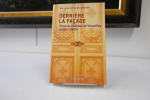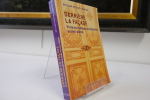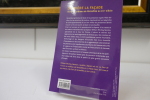11 books for « newton william r »Edit
-
Century
18th (1)
19th (3)
20th (2)
21st (3)
-
Topics
Astronomy (2)
History (2)
Isaac (1)
Literature (2)
Newton (5)
Sociology (1)
Stars (1)
Stars (1)
Tea (2)
Versailles (2)
-
Countries
Belgium (1)
Denmark (3)
France (7)
-
Syndicate
CLAM (1)
ILAB (9)
SLAM (5)
Derrière la Façade Vivre au château de Versailles au XVIII Si7cle
Perrin In-8°, broché, élégant ouvrage de 268 pagesenrichi d'un cahier photographique au centre.
Comme neuf Franco de port France jusqu'à 29 euros iclus. MONDIAL RELAY pour : FRANCE, Portugal, Pologne, Espagne, Allemagne, Autriche, Pays Bas, Luxembourg, Italie, Belgique. Toutes les étapes sont accompagnées. Achat, estimations et listages France / Suisse (sur rdv).
L'espace du roi - La cour de France au château de Versailles, 1682-1789
Le grand livre du mois. 2000. In-8. Broché. Bon état, Couv. convenable, Dos satisfaisant, Intérieur frais. 588 pages. Ex libris à l'encre en page de garde.. . . . Classification Dewey : 944.03-Histoire de France de 1589 à 1789
Préface de Jean-Pierre Babelon. Classification Dewey : 944.03-Histoire de France de 1589 à 1789
L'espace du roi: La cour de France au Chateau de Versailles, 1682-1789 (Divers Histoire) (French Edition)
2000 Fayard Soft cover
L'espace du roi: La cour de France au Chateau de Versailles, 1682-1789 (Divers Histoire) (French Edition) 240 x 165 mm, couverture souple avec bande de l'éditeur,588 pg, bon etat
DERRIERE LA FACADE - VIVRE AU CHATEAU DE VERSAILLES AU XVIIIe SIECLE
FRANCE LOISIRS / PERRIN. 2009. In-8. Relié. Bon état, Couv. convenable, Dos satisfaisant, Intérieur frais. 268 pages - quelques illustrations en couleur hors texte en milieu d'ouvrage, 2 cartes en noir et blanc en début d'ouvrage, jaquette en bon état. Avec Jaquette. . . Classification Dewey : 840-Littératures des langues romanes. Littérature française
Classification Dewey : 840-Littératures des langues romanes. Littérature française
Derrière la façade- Vivre au château de Versailles au XVIIIe siècle
Perrin. 2008. In-8. Broché. Bon état, Couv. convenable, Dos plié, Intérieur frais. 268 pages. Quelques planches de photos et illustrations en noir et blanc et couleurs, hors texte.. . . . Classification Dewey : 944.03-Histoire de France de 1589 à 1789
Classification Dewey : 944.03-Histoire de France de 1589 à 1789
Derrière la façade: Vivre au château de Versailles au XVIIIe siècle
Format : Broché, 288 pages; Dimensions : 14,2 x 21,1 x 2,4 cm; 2008. Vivre à Versailles sous Louis XV, ou comment se loger, se nourrir, se laver, se chauffer, s'éclairer, se blanchir etc. La réalité derrière les ors du plus grand palais du monde. Un livre sans équivalent. -EN PARFAIT ETAT-
Experiments for investigating the Cause of the coloured concentric Rings, discovered by Sir Isaac Newton. Read February 5, 1807. (+) Continuation of Experiments for investigating the Cause of coloured concentricRings, and other Appearances of a simila...
(London, W. Bulmer and Co., 1807 a. 1809). 4to. No wrappers as extracted from ""Philosophical Transactions"" 1807 - Part I. Pp. 180-233 a. 1 engraved plate., pp. 259-302 a. 3 large folded engraved plates.
First appearance of the 2 first papers in which Herschel tried to establish his own theory of light.""In a less happy venture into the physics of light, Herschel devoted three papers (1807-1810)- the two first offred here - to investigating the cause of colored concentric rings (""Newton's rings""). Ignoring the explanation already given by Thomas Young wherby the rings result from interference between light waves, Herschel ceriticized Newton' theory and attempted one of his own. he brought down on his head a storm of criticism, and this may have been a cause of his poor health at this period.""(DSB VI, p.333).
Recueil de Traités sur l'électricité, traduits de l'Allemand et de l'Anglois
Paris, Sebastien Jorry, 1748, , 3 parties en un volume in-12 : [2]-VII-[3]-156 pp. et 2 pl. + XII-141 pp. et 4 pl. + VIII-112 pp. et 1 pl. +, basane marbrée brune de l'époque, dos lisse et fleuronné, pièce de titre rouge, tranches rouges, Quatre ouvrages sont réunis dans ce volume qui présente l'état le plus avancé des recherches sur l'électricité à la veille des travaux de Benjamin Franklin : Winckler, Essai sur la nature, les effets et les causes, de l'électricité, avec une description de deux nouvelles machines à l'électricité. Première et seule édition française, elle est ornée de 2 planches gravées dépliantes figurant des machine à électricité. Watson, Expériences et observations, pour servir à l'explication de la nature et des propriétés de l'électricité. Première édition française traduite d'après la seconde édition anglaise. Les jolies planches sur cuivre qui l'accompagnent représentent des machines à électricité manipulées par d'élégants jeunes hommes et jeunes femmes. Watson, Essai sur la cause de l'électricité, où l'on examine, pourquoi certaines choses ne peuvent pas être électrifiées. Et quelle est l'influence de l'électricité dans les rhumatismes du corps humain, dans la nielle des arbres, dans les vapeurs des mines et dans la plante sensitive. Seconde édition française traduite Watson. Newton, Essai sur l'électricité, contenant des recherches sur sa nature, ses causes et propriétés, fondées sur la théorie du mouvement de vibration de la lumière et du feu de M. Newton... Première édition française traduite par Benjamin Martin. Une planche qui représente des éléments d'expérience électrique. Dos légèrement gauchi, minuscules épidermures, coiffe supérieure arasée, 1 mors fendu, rares taches. Étiquette et tampons de l'Institut catholique. Wheeler Gift, 313c ; Bakken, p. 100 et 118. Couverture rigide
Bon 3 parties en un volume in-12
HERSCHEL, WILLIAM. - INDICATION OF THE UNIVERSALITY OF NEWTON'S LAWS OF MOTION.
Reference : 42303
(1803)
Account of the Changes that have happened, during the last Twenty-five Years, in the relative Situation of Double-stars" with an Investigation of the Cause to which they are owing. Read June 9, 1803.
(London, Bulwer and Co., 1803). 4to. Without wrappers as extracted from ""Philosophical Transactions of the Royal Society of London."" Year 1803-Part II. Pp. 339-382 and 2 engraved plates.
First appearance of a fundamental paper in cosmology and physics as it contains the first observational data to support that Newton's dynamical laws holds outside the solar system. Herschel shows here that the circulating motions of double-stars were under gravitational forces. Until then the validity of the law of gravity was only established within the solar system. Now, a century after the establishment of the law, it was traced out in the motion of incredibly distant stars and the theory first truly earned its title of Universal. The exact proof of the mutual gravitation of the double-stars was only obtained five years after Herschel's death, when the motions of the stars were more precisely dtermined.One of the most notable of Herschel's discoveries of double-stars, binary stars. A first cataloque of such pairs was published early in 1782 and contained 269, of which 227 were new discoveries. ""Twenty years after the publication of his first cataloque Herschel was of Michell's opinion - Michell had expressed the opinion that the odds in favour of a physical relation between the members of herschel's newly discovered double stars were ""beyond arithmetic"" - but was able to support it by evidence of an entirely novel and much more direct character. A series of observations of Castor, presented in two papers in the ""Philosophical Transaction"" in 1803 (the paper offered here) and 1804, which were fortunately supplemented by an observation of Bradley's in 1759, had shewn a progressive alteration in the direction of the line joining its two components, of such a character as to leave no doubt that the two stars were revolving round one another"" and there were five oher cases in which a similar motion was observed...it was shown that the double-star was really formed by a connected pair of stars near enough to influence one another's mortion.""(Berry in ""A Short History of Astronomy"" pp. 342-43).
HERSCHEL, WILLIAM. - INDICATION OF THE UNIVERSALITY OF NEWTON'S LAWS OF MOTION - BINARY STARS.
Reference : 45133
(1803)
Account of the Changes that have happened, during the last Twenty-five Years, in the relative Situation of Double-stars" with an Investigation of the Cause to which they are owing. Read June 9, 1803. (+) Continuation of an Account ofthe Changes that h...
(London, Bulwer and Co., 1803 a. 1804). 4to. Without wrappers as extracted from ""Philosophical Transactions of the Royal Society of London."" Year 1803-Part II. Pp. 339-382 and 2 engraved plates. a. Year 1804-Part II. Pp. 353-384 a. 1 engraved plate. Light browning to a few margins. 2 plates with scattered brownspots, otherwise clean and wide-margined.
First appearance of these fundamental paper in cosmology and physics as they contains the FIRST OBSERVATIONAL DATA TO SUPPORT THAT NEWTON'S DYNAMICAL LAWS HOLDS OUTSIDE THE SOLAR SYSTEM. Herschel shows here that the circulating motions of double-stars were under gravitational forces. Until then the validity of the law of gravity was only established within the solar system. Now, a century after the establishment of the law, it was traced out in the motion of incredibly distant stars and the theory first truly earned its title of Universal. The exact proof of the mutual gravitation of the double-stars was only obtained five years after Herschel's death, when the motions of the stars were more precisely dtermined.One of the most notable of Herschel's discoveries of double-stars, binary stars. A first cataloque of such pairs was published early in 1782 and contained 269, of which 227 were new discoveries. ""Twenty years after the publication of his first cataloque Herschel was of Michell's opinion - Michell had expressed the opinion that the odds in favour of a physical relation between the members of Herschel's newly discovered double stars were ""beyond arithmetic"" - but was able to support it by evidence of an entirely novel and much more direct character. A series of observations of Castor, presented in two papers in the ""Philosophical Transaction"" in 1803 and 1804 (the paperS offered ), which were fortunately supplemented by an observation of Bradley's in 1759, had shewn a progressive alteration in the direction of the line joining its two components, of such a character as to leave no doubt that the two stars were revolving round one another"" and there were five oher cases in which a similar motion was observed...it was shown that the double-star was really formed by a connected pair of stars near enough to influence one another's mortion.""(Berry in ""A Short History of Astronomy"" pp. 342-43).
Derriere la facade : Vivre au château de Versailles au XVIII siècle
Sans date.
Très bon état - légères marques de lecture et/ou de stockage mais du reste en très bon état- expédié soigneusement depuis la France
 Write to the booksellers
Write to the booksellers








